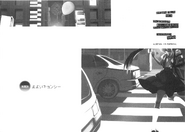Tag: Visual edit |
No edit summary |
||
| Line 19: | Line 19: | ||
|EISBN = 9781945054846<ref name="b8e"></ref> |
|EISBN = 9781945054846<ref name="b8e"></ref> |
||
|Ecover = [[Mayoi Hachikuji]] |
|Ecover = [[Mayoi Hachikuji]] |
||
| ⚫ | |||
| − | }} |
||
| ⚫ | |||
The English version is slated to release 28th of May 2018. |
The English version is slated to release 28th of May 2018. |
||
| Line 51: | Line 50: | ||
Kabuki-004.png |
Kabuki-004.png |
||
Kabuki-008.png |
Kabuki-008.png |
||
| + | </gallery> |
||
| + | |||
| + | ==English Edition Color Pages== |
||
| + | <gallery> |
||
| + | KabukiEngPage.jpg |
||
</gallery> |
</gallery> |
||
| Line 59: | Line 63: | ||
==Trivia== |
==Trivia== |
||
| − | *The English release of Kabukimonogatari is the second time a new translator has been introduced, being the first translation by Daniel Joseph. |
+ | *The English release of Kabukimonogatari is the second time a new translator has been introduced, being the first translation by Daniel Joseph. |
==References== |
==References== |
||
{{Reflist}} |
{{Reflist}} |
||
Revision as of 13:36, 7 June 2018
Kabukimonogatari (傾物語) or KABUKIMONOGATARI: Dandy Tale in the English publication, is the fifth part of the Monogatari series. It is the eighth book overall, and contains the story Mayoi Jiangshi (まよいキョンシー).
The English version is slated to release 28th of May 2018.
Etymology
The title is portmanteau of kabukimono, originally referring to flamboyantly dressed hooligans of the Edo period, and monogatari, "story". Kabukimono later came to refer more generally to people whose dress and behavior were ostentatious or outre, hence the translation of the title as Dandy Tale.
An English adaptation of this title could alterantely be twistory.
The kanji used to write "kabuki" (傾き) more typically reads as "katamuki" and means "slant, slope, inclination, deviation". As with some other Monogatari novels, it contains the BAKE part (化), and is composed of the simplified form of "person" (人) and "period of time" (頃). The character 頃 itself carries the original etymological meaning of "katamuki," it's component radicals having originally symbolized a person inclined to on side (ヒ) and a head (頁). It's meaning of tilting the head, and by extension something that causes one to tilt one's head in surprise or confusion, when paired with the person radical, is therefore perfectly suited to the meaning of kabukimono/dandy.
Synopsis
Araragi Koyomi and Oshino Shinobu decided to time travel back into 11 years ago using up the remaining spirit particles at the shrine from Nadeko Snake. In their adventure, Koyomi saved Hachikuji Mayoi from the car accident that killed her. When they returned to the present, they discover the world has changed drastically as a consequence of what Koyomi has done. Now they have to find an alternate way to get back to their original world.
English Release Synopsis
How far does one go to help a lost child? In the case of returning narrator Araragi, the answer is too far, across the veil of time. Dutifully (if unknowingly) following up on Hachikuji’s cheeky foreshadowing, he concerns himself with his young lady friend and her fate in this installment of the cult-hit series, heroically unable, once again, to find his own way home.
Thus the tale is also, or more so, about the journey itself, the dark honeymoon of a trip he takes into the past with the dweller in his shadow, Shinobu. Even among a cast that routinely disrespects chronology with their meta-commentary, she takes the cake, or the donut, by rewinding the clock for a perverse road movie, one that by and large goes nowhere, spatially.
It’s Kabuki not as in the theater, but with the character for “tilt”—as in a slanted attitude toward the world, the posture of a bohemian. Or, perhaps, of a legendary vampire who once sought death, and of a high school senior who once tuned out life doing their dandy best to attend to an embarrassing wealth of aberrations in a provincial town.
Introduced Characters
Plot
Mayoi Jiangshi
Illustrations
English Edition Color Pages
Anime
See also: Monogatari Series Second Season
Kabukimonogatari was adapted into the TV anime series through the compilation cour of Monogatari Series: Second Season as the second arc. For Blu-ray releases, it was released separately with it's original novel title.
Trivia
- The English release of Kabukimonogatari is the second time a new translator has been introduced, being the first translation by Daniel Joseph.
References
The Monogatari Series by Nisio Isin
| ||
|---|---|---|
| First Season | 1. Bakemonogatari (One) • 2. Bakemonogatari (Two) • 3. Kizumonogatari • 4. Nisemonogatari (One) • 5. Nisemonogatari (Two) • 6. Nekomonogatari (Black) | |
| Second Season | 7. Nekomonogatari (White) • 8. Kabukimonogatari • 9. Hanamonogatari • 10. Otorimonogatari • 11. Onimonogatari • 12. Koimonogatari | |
| Final Season | 13. Tsukimonogatari • 14. Koyomimonogatari • 15. Owarimonogatari (One) • 16. Owarimonogatari (Two) • 17. Owarimonogatari (Three) • 18. Zoku Owarimonogatari | |
| Off Season | 19. Orokamonogatari • 20. Wazamonogatari • 21. Nademonogatari • 22. Musubimonogatari • Tsugimonogatari | |
| Monster Season | 23. Shinobumonogatari • 24. Yoimonogatari • 25. Amarimonogatari • 26. Ougimonogatari • 27. Shinomonogatari (One) • 28. Shinomonogatari (Two) | |
| Family Season | 29. Ikusamonogatari • 30. Tsugimonogatari | |



